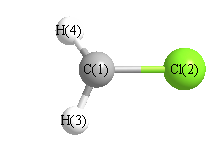Jump to
S1C2
Energy calculated at QCISD(T)=FULL/aug-cc-pVDZ
| | hartrees |
|---|
| Energy at 0K | -498.809226 |
| Energy at 298.15K | |
| HF Energy | -498.490408 |
| Nuclear repulsion energy | 44.816441 |
The energy at 298.15K was derived from the energy at 0K
and an integrated heat capacity that used the calculated vibrational frequencies.
Vibrational Frequencies calculated at QCISD(T)=FULL/aug-cc-pVDZ
| Mode Number |
Symmetry |
Frequency
(cm-1) |
Scaled Frequency
(cm-1) |
IR Intensities
(km mol-1) |
Raman Act
(Å4/u) |
Dep P |
Dep U |
|---|
| 1 |
A' |
3173 |
3078 |
|
|
|
|
| 2 |
A' |
1411 |
1369 |
|
|
|
|
| 3 |
A' |
832 |
807 |
|
|
|
|
| 4 |
A' |
212 |
206 |
|
|
|
|
| 5 |
A" |
3327 |
3228 |
|
|
|
|
| 6 |
A" |
987 |
958 |
|
|
|
|
Unscaled Zero Point Vibrational Energy (zpe) 4971.1 cm
-1
Scaled (by 0.9701) Zero Point Vibrational Energy (zpe) 4822.5 cm
-1
See section
III.C.1 List or set vibrational scaling factors
to change the scale factors used here.
See section
III.C.2
Calculate a vibrational scaling factor for a given set of molecules
to determine the least squares best scaling factor.
Geometric Data calculated at QCISD(T)=FULL/aug-cc-pVDZ
Point Group is Cs
Cartesians (Å)
| Atom |
x (Å) |
y (Å) |
z (Å) |
|---|
| C1 |
0.008 |
1.133 |
0.000 |
| Cl2 |
0.008 |
-0.592 |
0.000 |
| H3 |
-0.091 |
1.631 |
0.964 |
| H4 |
-0.091 |
1.631 |
-0.964 |
Atom - Atom Distances (Å)
| |
C1 |
Cl2 |
H3 |
H4 |
| C1 | | 1.7246 | 1.0899 | 1.0899 |
Cl2 | 1.7246 | | 2.4253 | 2.4253 | H3 | 1.0899 | 2.4253 | | 1.9283 | H4 | 1.0899 | 2.4253 | 1.9283 | |
 More geometry information
More geometry information
Calculated Bond Angles
| atom1 |
atom2 |
atom3 |
angle |
|
atom1 |
atom2 |
atom3 |
angle |
| Br2 |
C1 |
H3 |
117.221 |
|
Br2 |
C1 |
H4 |
117.221 |
| H3 |
C1 |
H4 |
124.410 |
|
Electronic energy levels
Charges, Dipole, Quadrupole and Polarizability
Jump to
S1C1
Energy calculated at QCISD(T)=FULL/aug-cc-pVDZ
| | hartrees |
|---|
| Energy at 0K | -498.809213 |
| Energy at 298.15K | |
| HF Energy | -498.490292 |
| Nuclear repulsion energy | 44.840793 |
The energy at 298.15K was derived from the energy at 0K
and an integrated heat capacity that used the calculated vibrational frequencies.
Vibrational Frequencies calculated at QCISD(T)=FULL/aug-cc-pVDZ
| Mode Number |
Symmetry |
Frequency
(cm-1) |
Scaled Frequency
(cm-1) |
IR Intensities
(km mol-1) |
Raman Act
(Å4/u) |
Dep P |
Dep U |
|---|
| 1 |
A1 |
3175 |
3080 |
|
|
|
|
| 2 |
A1 |
1414 |
1371 |
|
|
|
|
| 3 |
A1 |
835 |
810 |
|
|
|
|
| 4 |
B1 |
142i |
138i |
|
|
|
|
| 5 |
B2 |
3331 |
3231 |
|
|
|
|
| 6 |
B2 |
985 |
956 |
|
|
|
|
Unscaled Zero Point Vibrational Energy (zpe) 4798.9 cm
-1
Scaled (by 0.9701) Zero Point Vibrational Energy (zpe) 4655.4 cm
-1
See section
III.C.1 List or set vibrational scaling factors
to change the scale factors used here.
See section
III.C.2
Calculate a vibrational scaling factor for a given set of molecules
to determine the least squares best scaling factor.
Geometric Data calculated at QCISD(T)=FULL/aug-cc-pVDZ
Point Group is C2v
Cartesians (Å)
| Atom |
x (Å) |
y (Å) |
z (Å) |
|---|
| C1 |
0.000 |
0.000 |
-1.131 |
| Cl2 |
0.000 |
0.000 |
0.592 |
| H3 |
0.000 |
0.966 |
-1.636 |
| H4 |
0.000 |
-0.966 |
-1.636 |
Atom - Atom Distances (Å)
| |
C1 |
Cl2 |
H3 |
H4 |
| C1 | | 1.7229 | 1.0897 | 1.0897 |
Cl2 | 1.7229 | | 2.4277 | 2.4277 | H3 | 1.0897 | 2.4277 | | 1.9318 | H4 | 1.0897 | 2.4277 | 1.9318 | |
 More geometry information
More geometry information
Calculated Bond Angles
| atom1 |
atom2 |
atom3 |
angle |
|
atom1 |
atom2 |
atom3 |
angle |
| Br2 |
C1 |
H3 |
117.576 |
|
Br2 |
C1 |
H4 |
117.576 |
| H3 |
C1 |
H4 |
124.848 |
|
Electronic energy levels
Charges, Dipole, Quadrupole and Polarizability
